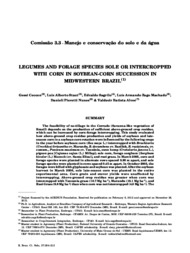Legumes and forage species sole or intercropped with corn in soybean-corn succession in midwestern Brazil.
Legumes and forage species sole or intercropped with corn in soybean-corn succession in midwestern Brazil.
Autoria: CECCON, G.; STAUT, L. A.; SAGRILO, E.; MACHADO, L. A. Z.; NUNES, D. P.; ALVES, V. B.
Resumo: The feasibility of no-tillage in the Cerrado (Savanna-like vegetation of Brazil) depends on the production of sufficient above-ground crop residue, which can be increased by corn-forage intercropping. This study evaluated how above-ground crop residue production and yields of soybean and lateseason corn in a soybean-corn rotation were influenced by the following crops in the year before soybean: corn (Zea mays L.) intercropped with Brachiaria (Urochloa) brizantha cv. Marandu, B. decumbens cv. Basilisk, B. ruziziensis, cv. comum., Panicum maximum cv. Tanzânia, sunn hemp (Crotalaria juncea L.), pigeon pea [Cajanus cajan (L.) Millsp]; sole corn, forage sorghum [Sorghum bicolor (L.) Moench (cv. Santa Elisa)], and ruzi grass. In March 2005, corn and forage species were planted in alternate rows spaced 0.90 m apart, and sole forage species were planted in rows spaced 0.45 m apart. In October 2005, the forages were killed with glyphosate and soybean was planted. After the soybean harvest in March 2006, sole late-season corn was planted in the entire experimental area. Corn grain and stover yields were unaffected by intercropping. Above-ground crop residue was greater when corn was intercropped with Tanzania grass (10.7 Mg ha-1), Marandu (10.1 Mg ha-1), and Ruzi Grass (9.8 Mg ha-1) than when corn was not intercropped (4.0 Mg ha-1). The intercropped treatments increased the percentage of soil surface covered with crop residue. Soybean and corn grain yields were higher after sole ruzi grass and intercropped ruzi grass than after other crops. The intercropping corn with Brachiaria spp. and corn with Panicum spp. increases above-ground crop residue production and maintains nutrients in the soil without reducing late-season corn yield and the viability of no-till in the midwestern region of Brazil.
Ano de publicação: 2013
Tipo de publicação: Artigo de periódico
Unidade: Embrapa Agropecuária Oeste
Palavras-chave: Above-ground crop residue, Biomass, Biomassa, Cerrado, Cobertura do solo, No-till, Plantio direto
Observações
1 - Por padrão são exibidas publicações dos últimos 20 anos. Para encontrar publicações mais antigas, configure o filtro ano de publicação, colocando o ano a partir do qual você deseja encontrar publicações. O filtro está na coluna da esquerda na busca acima.
2 - Para ler algumas publicações da Embrapa (apenas as que estão em formato ePub), é necessário ter, no celular ou computador, um desses softwares gratuitos. Sistemas Android: Google Play Livros; IOS: iBooks; Windows e Linux: software Calibre.
Acesse outras publicações
Acesse a Base de Dados da Pesquisa Agropecuária (BDPA) para consultar o acervo completo das bibliotecas da Embrapa.

